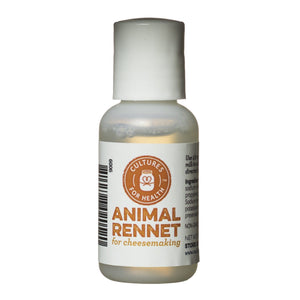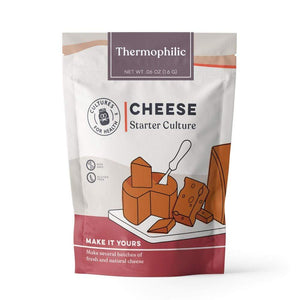
WHAT IS ASIAGO CHEESE?
Asiago is a firm, mold-pressed cheese originating in Italy. This cheese can be eaten after only 3 weeks of aging, but some people hold off and allow it to get older. The shorter-aged form of Asiago is sometimes referred to Asiago Pressato. Since this recipe makes two small wheels, you can try both delightful forms of Asiago.
5 minutes
4 hours
2 small wheels
INGREDIENTS AND EQUIPMENT AVAILABLE AT CULTURES FOR HEALTH
Liquid Animal Rennet

Liquid Animal Rennet
$9.49
High quality single strength animal rennet. This non-GMO animal rennet is preferred for aged cheese as it creates a more desirable flavor and aroma during the aging process. Each bottle contains enough rennet to set (12) 2-gallon batches of cheese.
Thermophilic Starter Culture

Thermophilic Starter Culture
$12.99
This useful culture makes a variety of hard cheeses, including parmesan, romano, provolone, and swiss.
Cheese Salt

HOW TO MAKE IT AT HOME
INGREDIENTS:
- 6 quarts whole milk
- 2 quarts skim milk
- 1/2 tsp. direct-set thermophilic culture
- 1/2 tsp. liquid rennet diluted in 1/4 cup cool water
- Cheese salt (for brining)
INSTRUCTIONS:
- Heat the milk together in a large pot over low heat. Bring the temperature up slowly to 92°F. (This should take about 25 minutes.)
- Stir in the starter by sprinkling it across the surface of the milk, letting it rehydrate for about 5 minutes before stirring it in thoroughly for 1 solid minute.
- Cover the milk and maintain the temperature at 92°F for 45 minutes. After this ripening time, stir in the rennet using long, up-and-down motions. Cover and let it set for 1 hour, continuing to maintain the temp at 92°F for the entire time.
- Once there is a clean break in the curd, cut the curd into 1/2-inch pieces and let them rest for about 5 minutes. Slowly start to bring the temperature to 104°F. Once the curds have reached 104°F, remove them from the heat and stir the curds continuously for 15 minutes to shrink the curds to about dime size.
- Place the pot back on the stove at low heat and carefully bring the heat up to 118°F, continuing to stir frequently. Once this temperature has been reached, stop stirring the curds and allow them to settle. Cover and maintain the temperature at 118°F.
- Use a ladle to remove the whey until you can just see the tops of the curds. Line two Italian draining baskets with cheesecloth and place them on a draining rack. Spoon the warm cheese curds into the lined molds. Pull the tails of the cheesecloth up and over the top of the curds. Gently compact the curds into the mold by pressing the curds a few times with the back of your hand.
- Place a follower on top of the filled molds and press at 8 pounds of pressure for 1 hour. Remove, flip, and re-dress the cheese, then press at 8 pounds again for 8 more hours.
- While the cheese is being pressed, make about a gallon of saturated brine (32 ounces of salt to 1 gallon of water) and chill it to 50°F. After the cheeses are pressed, take them out of the molds and put them in the brine. Place them somewhere cool, like the refrigerator, to soak for 12 hours. Flip them a few times during the soaking period.
- Take the cheeses out of the brine and pat them dry. Place them on a drying rack and cover with clean cheesecloth. Air-dry for several days or until the surface of the cheese is dry to the touch. Flip cheese a few times during the drying process.
- Place the cheeses in a ripening box, cave, or cellar and cover them loosely. Keep the ripening area cool and humid. (About 85% humidity is preferable.) To deter mold and help rind development, brush the cheeses with brine about twice a week for 3 weeks. At 3 weeks, the Asiago will be ready to eat, but you can age it longer by just continuing to brush it twice a week for 3 months to a year.
Check our other cheese cultures that are best in cheese making process.
















